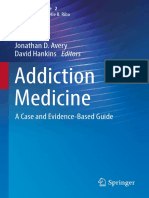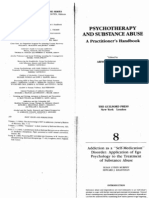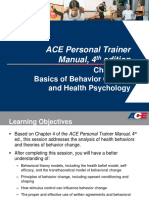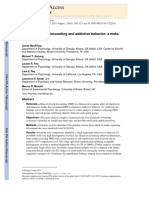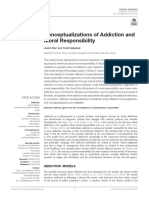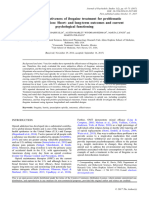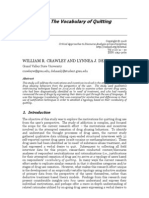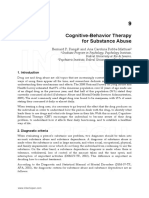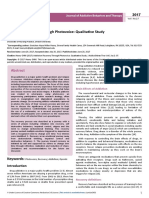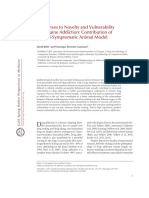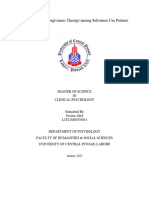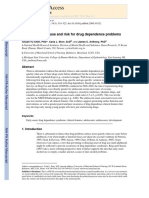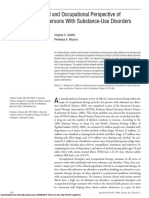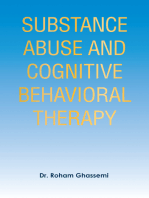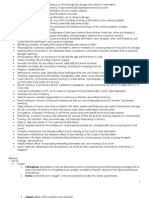NIH Public Access: Mindfulness-Based Relapse Prevention For Substance Craving
NIH Public Access: Mindfulness-Based Relapse Prevention For Substance Craving
Uploaded by
tugba1234Copyright:
Available Formats
NIH Public Access: Mindfulness-Based Relapse Prevention For Substance Craving
NIH Public Access: Mindfulness-Based Relapse Prevention For Substance Craving
Uploaded by
tugba1234Original Title
Copyright
Available Formats
Share this document
Did you find this document useful?
Is this content inappropriate?
Copyright:
Available Formats
NIH Public Access: Mindfulness-Based Relapse Prevention For Substance Craving
NIH Public Access: Mindfulness-Based Relapse Prevention For Substance Craving
Uploaded by
tugba1234Copyright:
Available Formats
NIH Public Access
Author Manuscript
Addict Behav. Author manuscript; available in PMC 2014 February 01.
Published in final edited form as:
Addict Behav. 2013 February ; 38(2): 1563–1571. doi:10.1016/j.addbeh.2012.04.001.
Mindfulness-Based Relapse Prevention for Substance Craving
Katie Witkiewitza,a, Sarah Bowen, PHDb, Haley Douglasc, and Sharon H. Hsuc
aDepartment of Psychology, Washington State University-Vancouver
$watermark-text
bCenterfor the Study of Health and Risk Behaviors, Department of Psychiatry, University of
Washington, Box 354944, 1100 NE 45th St, Suite 300, Seattle WA 98105 USA.
swbowen@uw.edu
cDepartment
of Psychology, University of Washington, Box 351525, Seattle WA 98195 USA.
hacdougl@uw.edu and shsinhsu@gmail.com
Abstract
Craving, defined as the subjective experience of an urge or desire to use substances, has been
identified in clinical, laboratory, and preclinical studies as a significant predictor of substance use,
substance use disorder, and relapse following treatment for a substance use disorder. Various
models of craving have been proposed from biological, cognitive, and/or affective perspectives,
$watermark-text
and, collectively, these models of craving have informed the research and treatment of addictive
behaviors. In this article we discuss craving from a mindfulness perspective, and specifically how
mindfulness-based relapse prevention (MBRP) may be effective in reducing substance craving.
We present secondary analyses of data from a randomized controlled trial that examined MBRP as
an aftercare treatment for substance use disorders. In the primary analyses of the data from this
trial, Bowen and colleagues (2009) found that individuals who received MBRP reported
significantly lower levels of craving following treatment, in comparison to a treatment-as-usual
control group, which mediated subsequent substance use outcomes. In the current study, we
extend these findings to examine potential mechanisms by which MBRP might be associated with
lower levels of craving. Results indicated that a latent factor representing scores on measures of
acceptance, awareness, and nonjudgment significantly mediated the relation between receiving
MBRP and self-reported levels of craving immediately following treatment. The mediation
findings are consistent with the goals of MBRP and highlight the importance of interventions that
$watermark-text
increase acceptance and awareness, and help clients foster a nonjudgmental attitude toward their
experience. Attending to these processes may target both the experience of and response to
craving.
© 2012 Elsevier Ltd. All rights reserved
a
Corresponding author: Katie Witkiewitz, PhD, Department of Psychology, Washington State University-Vancouver, 14204 NE
Salmon Creek Ave, Vancouver WA 98686 USA. katie.witkiewitz@wsu.edu, phone: 360-546-9403, fax: 360-546-9038.
Publisher's Disclaimer: This is a PDF file of an unedited manuscript that has been accepted for publication. As a service to our
customers we are providing this early version of the manuscript. The manuscript will undergo copyediting, typesetting, and review of
the resulting proof before it is published in its final citable form. Please note that during the production process errors may be
discovered which could affect the content, and all legal disclaimers that apply to the journal pertain.
Contributors: Katie Witkiewitz and Sarah Bowen designed the study and wrote the protocol. Sharon Hsu was integral to the
execution of the study and the participant assessments. Haley Douglas and Sharon Hsu conducted literature searches and provided
summaries of previous research studies. Katie Witkiewitz conducted the statistical analysis. Katie Witkiewitz and Sarah Bowen wrote
the first draft of the manuscript and all authors contributed to and have approved the final manuscript.
Conflict of Interest: All other authors declare that they have no conflicts of interest.
Witkiewitz et al. Page 2
Keywords
craving; substance use disorder; mindfulness; relapse prevention; MBRP
1. Introduction1
Over the past decade, substance use disorder has been conceptualized as a chronic relapsing
condition (McLellan, 2002; McLellan, McKay, Forman, Cacciola, & Kemp, 2005), where
relapse has been variously defined as either the return to problematic substance use
following treatment or as a process of behavior change (Brownell, Marlatt, Lichtenstein, &
$watermark-text
Wilson, 1986; Maisto, Pollock, Cornelius, Lynch, & Martin, 2003; Witkiewitz & Marlatt,
2004). A substantial amount of research over the past 20 years has focused on identifying
predictors of relapse and developing treatments (including pharmacological and
psychological) that may help prevent relapse. One of the strongest predictors of relapse to
emerge in both pre-clinical and clinical research studies is craving (Anton, 1999; Breese,
Sinha, & Heilig, 2011; Drummond, 2001; Marlatt, 1978; Shadel et al., 2011; Sinha &
O'Malley, 1999), and many of the promising pharmacotherapies and most effective
psychotherapies for addiction have focused on reducing or managing substance craving. In
the current paper, we review the efficacy of mindfulness-based relapse prevention as a
treatment for substance use disorders and empirically examine mechanisms of action for
reduction of substance craving.
1.1. Substance Craving
$watermark-text
The concept of “craving” as an essential facet of substance use disorders is generally
accepted by researchers, clinicians and patients, yet operational and conceptual definitions
vary widely (Anton, 1999; Potgieter, Deckers, & Geerlings, 1999; Rosenberg, 2009; Skinner
& Aubin, 2010; Tiffany, Carter, & Singleton, 2000). Skinner and Aubin (2010) reviewed 18
models of craving that have emerged over the past 60 years, and concluded that while
collectively the models of craving have been indispensible in the research and treatment of
addictive behaviors, none of the models independently provide a complete explanation of
the craving construct. For the purposes of the current paper, we define craving as the
subjective experience of an urge or desire to use substances. Consistent with numerous
models of craving, we acknowledge that it can be experienced as intrusive thoughts and the
elaboration of intrusive thoughts (Kavanagh et al., 2006), an impulsive drive or motivation
(Cox & Klinger, 2002), substance wanting (Robinson & Berridge, 1993), an emotional state
$watermark-text
(Tiffany & Wray, 2009), a physical sensation (Paulus, 2007), a stress response (Sinha & Li,
2007), or any other manifestation that is salient for an individual who endorses experiencing
“craving” or an “urge” to use substances.
The roots of craving can be attributed to biological, affective, or cognitive motivators.
Within biological models of craving, addiction is viewed as a brain disease, and the etiology
of substance craving and substance use are both born out of neurobiological and
physiological states (Robinson & Berridge, 1993; Wise, 1988). Craving can be reflected in
neural states, as suggested by studies linking neurotransmitters such as dopamine, serotonin,
and gamma-aminobutyric acid (GABA) to drug use (Johnson, Seutin, & North, 1992; Wise,
1988) and/or alcohol use (Addolorato, Leggio, Abenavoli, & Gasbarrini, 2005; Verheul, van
den Brink, & Geerlings, 1999). For example, dopamine in the dorsal striatum has been
1Abbreviations. MBRP = mindfulness-based relapse prevention, TAU = treatment as usual, PACS = Penn Alcohol Craving Scale,
AAQ = Acceptance and Action Questionnaire, FFMQ = Five Facet Mindfulness Questionnaire, ACT = Acting with Awareness
subscale of the FFMQ, NONJ = Nonjudgmental awareness subscale of FFMQ, CFI = Comparative Fit Index, RMSEA = Root Mean
Square Error of Approximation, SE = standard error
Addict Behav. Author manuscript; available in PMC 2014 February 01.
Witkiewitz et al. Page 3
associated with reported craving (Volkow et al., 2006), and GABA dysregulation has been
associated with a craving drive described as a relief of tension (Addolorato, Abenavoli,
Leggio, & Gasbarrini, 2005). Other biological models of craving focus on physiological
withdrawal states, wherein craving can occur as interoceptive dysregulation (Goldstein et
al., 2009; Paulus & Stein, 2006).
Affective models suggest that craving is an emotion that can be elicited by affective
expectancies, negative affect or stress (Baker, Morse, & Sherman, 1986; Wikler, 1948). In
terms of positive expectancy, craving for drug use is elicited with positive associations with
the effects of drug use. With negative affect, craving is suggested to be a state elicited by the
avoidance of negative affect or stress associated with withdrawal such that craving can be
$watermark-text
both the result and cause of stress (Sinha & Li, 2007). Thus, the core motivation to avoid
negative affective states is the cause of craving (Baker, Piper, Fiore, McCarthy, & Majeskie,
2004). In support, stress- and negative-affect-induced states have been shown to increase
craving in the laboratory (Sinha & O'Malley, 1999). Further, negative affect is one of the
most frequently endorsed reasons for relapse (Brownell et al., 1986; Marlatt & Gordon,
1985). Within an affective model of craving, affective states can elicit craving or prevent
individuals from inhibiting craving.
From a cognitive perspective, it is suggested that craving is rooted in cognitive processes
(e.g., memory, expectancies) that reflect higher-order information processing (Tiffany,
1999) that evolve into automatic processes of use (Tiffany, 1990). For example, Marlatt
posits that craving is a result of cognitive expectancies for drug use (Marlatt, 1978; Marlatt
& Gordon, 1985). Stress-induced craving is an example of how cognitive interpretations of
$watermark-text
an event can trigger craving, even in a laboratory setting (Sinha & Li, 2007). Additional
evidence suggests that self-efficacy is a critical factor in the relation between craving and
substance use (Marlatt & Witkiewitz, 2005). Hence, cognitive models of craving clearly
outline craving as a psychological process, separate from drug use, whereby craving can
occur without substance use, and substance use can occur without craving (Skinner &
Aubin, 2010).
While these perspectives provide unique explanations of the causes of craving, many
specific models of craving are a complex amalgam of biological, affective and cognitive
constructs. For example, the withdrawal model (Wikler, 1948) describes craving, or the
drive to use, as a result of both a biological conditioned response to drug related stimuli, and
an attempt to escape negative affective states. Additionally, the theory of neural opponent
motivation identifies craving as a biological deviation from the homeostatic regulation of
$watermark-text
neurotransmitters that can be elicited by change in affective states (Koob & Le Moal, 2001,
2008).
Different perspectives on craving imply unique implications for treatment. A cognitive
perspective of craving treatment might target working memory (Houben, Wiers, & Jansen,
2011) or re-training attention to push substance cues away (Wiers, Rinck, Kordts, Houben,
& Strack, 2010). An affective process perspective might focus on disrupting the association
between negative affective states and the desire to use. A neurobiological perspective would
be interested in directly targeting neurobiological dysfunction to impact craving (Volkow et
al., 2006).
1.2. A Mindfulness Perspective on Craving
A fourth perspective on craving, of particular interest to the present study, comes from the
mindfulness literature, and the use of mindfulness-based treatments to reduce and cope with
craving. Such a perspective has the potential to advance the conceptualization and the
treatment of neurobiological, cognitive, and affective aspects of craving.
Addict Behav. Author manuscript; available in PMC 2014 February 01.
Witkiewitz et al. Page 4
Mindfulness has been described as, “the awareness that emerges through paying attention,
on purpose, in the present moment, and nonjudgmentally to the unfolding of experience”
(pg. 145; Kabat-Zinn, 2003). While secularized in most Western treatment contexts,
mindfulness meditation has roots in the Buddhist tradition. From a Buddhist perspective,
craving is considered a core component of human existence, and craving and attachment are
viewed as the root cause of human suffering (Bodhi, 2005). From a mindfulness perspective,
we might view addiction as an effort to either hold on to or avoid cognitive, affective or
physical experiences. In an effort to avoid suffering, an individual either clings onto positive
states (e.g., craving the next high) or avoids negative states (e.g., seeking an escape from
sadness). Mindfulness practice includes observing craving, which is considered to be a
transient cognitive and affective phenomenon, just like any other experience. Thus, the
$watermark-text
intention of the practice is to bring awareness to the experience of craving and to learn to
observe it without reacting and without judgment.
Another intention of mindfulness practice is to increase acceptance of one's experience,
allowing one to experience his or her current physical and affective state as impermanent. In
recognizing that neither positive nor negative states are enduring, an individual realizes that
the effort exerted to achieve or cling to a particular state of being is not only futile, but
causes suffering. The practice of accepting physical and affective states as they are in the
present moment is counter to the clinging quality of craving (Breslin, Zack, & McMain,
2002). Finally, the practice of mindfulness meditation has been shown to reduce neural
aspects of craving (Westbrook et al., 2011). Specifically, Westbrook and colleagues (2011)
found that the brain regions that are typically activated during craving (including the
subgenual anterior cingulate cortex) showed reduced activity during mindful attention of
$watermark-text
smoking images, as compared to looking at the smoking images without mindful attention.
Furthermore, during mindful attention, there was significantly reduced functional
connectivity between the subgenual anterior cingulate cortex and other regions associated
with craving, including the ventral striatum and the bilateral insula. Taken together, there is
evidence to suggest that mindfulness-based treatment has the potential in addressing
neurobiological, cognitive, and affective aspects of craving.
1.3. Mindfulness-Based Relapse Prevention
Drawing from the Buddhist tradition, Marlatt (2002) recognized that craving and addiction
could be targeted by mindfulness meditation, but that many individuals might need
additional cognitive and behavioral skills for coping with high risk situations for relapse. In
response to the need for integrating mindfulness meditation with cognitive-behavioral skills
$watermark-text
training for addiction, Mindfulness-Based Relapse Prevention (MBRP; Bowen, Chawla, &
Marlatt, 2010; Witkiewitz, Marlatt, & Walker, 2005), was developed as an aftercare
treatment program that was designed to reduce the risk and severity of relapse following
intensive substance abuse treatment.
1.3.1. The Mindfulness-Based Relapse Prevention Program—The MBRP program
consists of eight 2-hour sessions, each including formal mindfulness practices, as well as
exercises and skills designed to bring these practices into daily life, specifically into
situations in which an individual is at high risk for relapse. The first three sessions focus on
raising awareness of environmental triggers, and the physical, affective and cognitive
reactions that follow, bringing awareness to the progression of reactions that occur in
response to such cues. Clients learn “informal” mindfulness practices based on the
foundational meditation practice they have built thus far to step out of the habitual cognitive
and behavioral patterns and choose a more skillful response. As early as session two, clients
engage in exercises specifically focused on coping with craving. Through in-session
exercises designed to elicit craving, clients practice bringing awareness to the multiple
Addict Behav. Author manuscript; available in PMC 2014 February 01.
Witkiewitz et al. Page 5
components of their experience while slowly increasing exposure and intensity to the
craving response. They practice approaching the reactions with a gentle curiosity, and are
given instructions to guide them through “staying with” the experience without exacerbating
it, giving into it, or attempting to suppress it. The exercise allows clients to practice imaginal
exposure and nonreactivity to substance use triggers. They learn skills to stay in contact with
the internal reactions to external triggers (i.e., craving in response to substance use cues) that
put them at high risk for relapse. Additionally, they learn an alternative, competing response
to craving by approaching the experience with curious awareness, deescalating the process
by not engaging in habitual cognitive or behavioral patterns that tend to intensify the craving
reaction.
$watermark-text
In order to increase ability to tolerate the discomfort often associated with craving and other
reactions to triggers clients maintain an ongoing practice of both formal meditation and of
exercises designed to increase awareness of triggers and reactions. They begin to increase
their ability to endure the affective and physical discomfort without reacting in ways that
may temporarily relieve distress, but lead to problematic longer-term outcomes. The final
two sessions of the course focus on social and environmental factors that either support or
detract from the maintenance of treatment gains and an ongoing mindfulness practice.
1.3.2. Pilot Randomized Trial of Mindfulness-Based Relapse Prevention—A
randomized pilot trial was conducted to assess feasibility and establish initial efficacy of the
MBRP treatment protocol (Bowen et al., 2009). Participants (N = 168) were clients from a
private, nonprofit treatment agency providing a continuum of care to adults with alcohol or
other drug use disorders. To be eligible for the study, individuals had to have completed
$watermark-text
either inpatient or intensive outpatient treatment, and be medically stable to progress into
aftercare. As such, all participants had completed initial treatment immediately prior to
entering the trial, and were thus in early stages of abstinence. Clients with psychotic
disorders or acute suicidality were excluded from participating.
Following a web-based baseline battery of assessments, participants were randomized to
either MBRP or to treatment as usual (TAU) as delivered by the agency, which consisted
primarily of 12-step treatment and psychoeducational programming. Analyses in the parent
study (Bowen et al., 2009) revealed a difference in racial distribution between groups at
baseline, with a higher percentage of White participants in MBRP (63%) than TAU (45%).
This difference was a not a systematic effect of randomization; thus, race was used as a
covariate in all analyses in the parent study (Bowen et al., 2009). There were no other
$watermark-text
baseline differences between groups in demographic or main outcome variables. Overall,
this indicates that randomization was successful.
Following the 8-week treatment period, participants randomized to the MBRP condition
returned to their regular agency aftercare programs. As described in more detail in Section 2,
assessments were given at baseline, immediately following the 8-week treatment period, and
2 and 4 months following the treatment. Individual characteristics, psychosocial factors and
substance use in the 60day period prior to entering initial inpatient or intensive outpatient
treatment were assessed. MBRP and TAU participants reported using substances on 27 (SD
= 24) and 28.9 (SD =24.8) days, respectively (Bowen et al., 2009). This difference was not
statistically significant.
With respect to substance use outcomes, participants in both groups had a low base rate of
substance use during and following treatment, with average days of use over the follow-up
of 9.33 days for TAU (SD = 20.80) and 5.62 days for MBRP (SD = 14.33). Across both
groups, fewer than 30% of participants (29.1% in TAU, 28.6% in MBRP) had any days of
use. Of those who used, 28.6% and 33.3% of TAU and MBRP participants, respectively,
Addict Behav. Author manuscript; available in PMC 2014 February 01.
Witkiewitz et al. Page 6
only used substances on one day during the follow-up period. A curvilinear effect of
treatment on substance use outcomes suggested that treatment gains made by MBRP
participants, compared to TAU participants, decayed by 4 months post-treatment. Analyses
of craving showed a significantly greater decrease over the 4-month follow-up period in
MBRP participants as compared to those in TAU. Additionally, there were significant
increases in acceptance, as measured by the Acceptance and Action Questionnaire (Hayes et
al., 2004), in MBRP versus TAU participants. Secondary analyses of data from the study by
Bowen and colleagues (2009) found individuals who received MBRP were less likely to
experience craving in response to depressed mood and the attenuated reactivity to depressed
mood and reduced craving also predicted fewer days of substance use for those who
received MBRP (Witkiewitz & Bowen, 2010). Based on these findings, we hypothesized
$watermark-text
that MBRP may extinguish the habitual response of subjective craving during periods of
negative mood. Yet, previous studies have not examined mechanisms by which MBRP
might reduce craving or alter the response of craving during negative mood states.
Given the basic tenets of MBRP, we propose numerous factors may predict levels of self-
reported craving and changes in craving over time following MBRP. As noted above, one of
the primary goals of MBRP is to target both the experience of and response to craving.
Through several exercises and practices, clients increase their awareness of triggers that
elicit craving and of the “automatic” craving reaction in response to these triggers. They
practice acceptance of the discomfort often associated with triggers that may have, in the
past, led to craving for escape relief, such as a desire for a substance to decrease the intensity
of the negative affective, cognitive, or physical state. Finally, clients practice relating to their
experiences and reactions with a nonjudgmental attitude, decreasing the distress often
$watermark-text
associated with self-judgment, frustration or shame in relation to craving or use.
We hypothesize that awareness, acceptance and nonjudgment function as necessary and
interdependent processes, each supporting one another, and each an essential factor in the
mitigation of the craving response. For example, awareness is a necessary condition for
acceptance, i.e., an individual cannot truly accept something of which he or she is not aware.
However, an individual may be aware of his or her experience but unwilling or unable to
accept it. This individual may be more likely to attempt to deny or suppress the experience
of craving, which may in turn result in even greater craving (Berry, May, Andrade, &
Kavanagh, 2010). Finally, an individual may be aware of an experience, such as an affective
response to a substance use trigger, but may experience self-judgment or shame about the
reaction, increasing levels of negative affect and thus putting the individual at greater risk of
$watermark-text
increased craving. Thus, we hypothesized that a latent factor indicated by acceptance of
experience, acting with awareness, and a non-judgmental attitude toward inner experience,
would predict lower levels of craving and would mediate the association between receiving
MBRP and changes in craving over time.
1.4. Current Study
The goal of the current study was to follow-up on the significant effect of MBRP on post-
treatment craving scores reported by Bowen and colleagues (2009) by examining
theoretically driven mechanisms of change. The first goal of the current study was to
examine the effect of MBRP on levels of craving and changes in craving over time in a
latent growth modeling framework to estimate the between-person and within-person
variability in craving scores over time. The second goal was to build upon the study by
Bowen and colleagues (2009) by examining whether changes in acting with awareness,
acceptance, and nonjudgement mediated the association between participation in MBRP and
self-reported changes in craving during and following MBRP.
Addict Behav. Author manuscript; available in PMC 2014 February 01.
Witkiewitz et al. Page 7
2. Materials and Methods
2.1. Participants
Participants (N = 168) were recruited from a private, nonprofit agency providing a
continuum of care for alcohol and drug use disorders, serving approximately 126 clients per
month in both inpatient and outpatient settings. Approximately 57% of the agency's
outpatient and 2% of inpatient clients are legally mandated to substance abuse treatment,
and 19% of outpatient and 75% of inpatient clients are homeless. Roughly 55% of clients
complete treatment as recommended. Eligible participants were between the ages of 18 and
70, fluent in English, had completed intensive outpatient or inpatient treatment in the
previous 2 weeks, and were medically cleared for participation. Exclusion criteria included
$watermark-text
psychosis, dementia, imminent suicide risk, significant withdrawal risk, need for more
intensive treatment, or not completing inpatient or intensive outpatient treatment. Out of 260
individuals screened, 29% (n = 73) failed to meet eligibility criteria, with primary exclusions
being not completing the treatment program prior to the study enrollment (n = 58), active
psychosis (n = 10), scheduling conflicts (n = 4), and active suicidality (n = 1). Of those
eligible to participate (n = 187), eighteen declined participation or failed to attend the
baseline appointment and one individuals refused to be randomized. In anticipation of higher
attrition in a novel treatment, we oversampled for the MBRP condition by 10%.
Randomization was conducted using a web-based random number sequencer (http://
www.randomizer.org). For the final total sample size of 168, of which 93 (55%) were
randomized to MBRP and 75 (45%) were randomized to TAU, reflecting the oversampling
for the MBRP treatment group.
$watermark-text
The majority of participants (63.7%) were male, with an average age of 40.5 (10.3) years.
Approximately half identified as Caucasian (51.8%), followed by African American
(28.6%), Multiracial (15.3%), and Native American (7.7%). Approximately 41.3% reported
being unemployed, with 32.9% receiving some form of public assistance, and 62.3% earning
less than $4999 per year. Approximately 45.2% of the sample reported alcohol as their
primary substance of abuse, followed by cocaine/crack (36.2%), methamphetamines
(13.7%), opiates/heroin (7.1%), marijuana (5.4%), and other (1.9%). Approximately 19.1%
reported polysubstance use. Over 40% of the sample was in treatment for legal reasons (e.g.,
treatment was court ordered) and for many individuals substance use was prohibited during
and following treatment.
2.2. Procedures
$watermark-text
All study procedures were approved by the University of Washington Institutional Review
Board. No side effects of treatment or adverse events during the course of the study were
detected or reported. Participants were recruited near the end of their inpatient or outpatient
treatment through flyers and referrals from agency or research staff. Potential participants
contacted research staff by telephone, provided verbal consent for screening, and completed
a 30–45 minute telephone eligibility screen. Following informed consent procedures,
eligible participants completed a web-based baseline assessment in a private room at the
treatment agency, with research staff available to assist or answer participants' questions.
Each participant was assigned a unique study ID number, which also serves as the ID
number for accessing the subsequent follow-up web-based assessments, which participants
were free to complete at a location of their choosing. Following completion of the
assessment, participants were randomly assigned (using a computerized random number
generator) to either 8-weeks of MBRP or continuation of their existing treatment (treatment
as usual, TAU). Participants randomized to MBRP agreed to discontinue TAU for the 8-
weeks of the course, and to resume TAU following completion of MBRP. MBRP
participants were scheduled to complete a web-based follow-up assessment immediately
Addict Behav. Author manuscript; available in PMC 2014 February 01.
Witkiewitz et al. Page 8
following the 8-week course, and 2-months and 4-months following the intervention. TAU
participants followed the same schedule. Reminder calls for follow-up assessments were
made to each cohort according to assessment schedule. Given that the assessment was web-
based, participants were given the option to complete the assessment on their own or
schedule an appointment at the treatment agency. Participants who did not complete their
scheduled follow-up assessments were contacted via telephone to document their substance
use. All participants received $45 gift cards for completion of baseline and post-intervention
assessments, and a $50 gift card for completion of 2- and 4-month assessments. All
participants, regardless of assignment, were encouraged to continue attending any additional
community 12-step or other self-help meetings as recommended by the treatment agency.
$watermark-text
MBRP was delivered by two therapists to groups of 6–10 participants. Sessions were
conducted in the group therapy room at the treatment agency. Closed cohorts met weekly for
eight two-hour sessions. Sessions included guided meditations, experiential exercises, and
discussion. Participants were assigned daily exercises to practice between sessions, and were
given CDs for daily meditation practice. Relapse prevention practices (Daley & Marlatt,
1992) were integrated into the mindfulness-based skills. MBRP therapists held master's
degrees in psychology or social work, and all had a background in cognitive-behavioral
interventions and mindfulness meditation practice. All sessions were audio recorded, and
treatment fidelity was assessed by a team of coders who were trained to identify key
content- and style-related components of MBRP, using The Mindfulness-Based Relapse
Prevention Adherence and Competence Scale (Chawla et al., 2010).
Participants in the TAU condition continued in their standard, rolling admission outpatient
$watermark-text
aftercare, which included work in the 12-step model, process-oriented groups, and
psychoeducation. Relapse prevention skills, based on the disease model of addiction
(Gorski, 1990), were included in some of the groups. Therapists facilitating the TAU groups
were licensed Chemical Dependency Counselors, with diverse clinical training and
experience.
2.3. Measures
All measures were self-report, and were administered via a web-based assessment program
with staff available to assist participants in using the assessment interface. Research has
found no significant differences between paper-and-pencil and web administration of
commonly utilized measures (Miller et al., 2002). The measures used in the current analyses
are described below and interested readers are referred to prior publications from this study
$watermark-text
for more information about other measures (Bowen et al., 2009).
2.3.1. Alcohol and Drug Craving—The Penn Alcohol Craving Scale (PACS; Flannery,
Volpicelli, & Pettinati, 1999), a five-item self-report measure, was adapted to include
craving for both alcohol and other drugs. The PACS measures frequency, intensity, and
duration of craving, as well as an overall rating of craving for the previous week. The PACS
has shown excellent internal consistency and predictive validity for alcohol relapse. The
internal consistency of the PACS in the current sample was 0.87.
2.3.2. Awareness—The “acting with awareness” and “non-judgment” subscales of the
Five Factor Mindfulness Questionnaire (FFMQ; Baer, Smith, Hopkins, Krietemeyer, &
Toney, 2006) were used as measures of awareness and nonjudgment in the current study.
The FFMQ consists of 39 items and five subscales (1) “observe,” (notice or attend to
internal and external phenomena); (2) “describe,” (label observed phenomena such as
thoughts and emotions); (3) “acting with awareness,” (engage with full awareness in current
experience or activity); (4) “non-judgment,” (nonjudgmental awareness of current
Addict Behav. Author manuscript; available in PMC 2014 February 01.
Witkiewitz et al. Page 9
experience without evaluation); and (5) “non-reactivity,” (notice internal phenomena
without reacting). Internal consistency of the FFMQ in the current study was .91, with
subscale alphas ranging from .80–.87.
Sample items from the acting with awareness subscale include: “I find it difficult to stay
focused on what's happening in the present” and, “It seems I am “running on automatic”
without much awareness of what I'm doing.” Sample items from the non-judgment subscale
include: “I criticize myself for having irrational or inappropriate emotions” and, “When I
have distressing thoughts or images, I judge myself as good or bad, depending on what the
thought/image is about.” Items are rated on a 5-point Likert-type scale (always true to never
true) with higher scores indicating greater awareness and non-judgment.
$watermark-text
2.3.3. Acceptance—Acceptance was measured using the Acceptance and Action
Questionnaire (AAQ; Hayes et al., 2004). The AAQ is a 9-item instrument that assesses
acceptance versus avoidance and control of negative private experiences. Internal
consistency of this measure in the current study was .68. Sample items include, “When I
evaluate something negatively, I usually recognize that this is just a reaction, not an
objective fact” and, “If I could magically remove all the painful experiences I've had in my
life, I would do so” (reverse coded). Items are rated on a 7-point Likert-type scale with
higher scores indicating greater acceptance.
2.4. Statistical Analyses
To examine the hypotheses outlined above, a series of latent variable growth models were
$watermark-text
estimated using Mplus version 6.11(Muthén & Muthén, 2010). First, unconditional models
of self-reported craving were estimated separately without covariates using a systematic
process of model testing whereby an intercept-only model was compared to increasingly
complex functional forms (e.g., linear slope, linear + quadratic slope, nonlinear slope).
Model fit of all models was evaluated by χ2 values, the Root Mean Square Error of
Approximation (RMSEA) (Browne & Cudeck, 1993), and the Comparative Fit Index (CFI)
(Bentler, 1990). Models with non-significant χ2, RMSEA less than 0.06, and CFI greater
than 0.95 were considered a good fit to the observed data (Hu & Bentler, 1999).
After establishing the unconditional model of craving, we examined the association between
treatment group and craving changes over time by including treatment condition (dummy
coded as “treatment as usual = 0” and “MBRP = 1”) as a covariate predictor of the craving
growth factors. Race and treatment hours (total hours of treatment received including MBRP
$watermark-text
groups as recorded in agency records), which have been shown to influence outcomes in the
current sample (Bowen et al., 2009; Witkiewitz & Bowen, 2010), were also included as
covariate predictors of the craving growth factors in all analyses.
Next, we examined whether a latent factor indicated by acceptance, nonjudgmental
awareness, and acting with awareness provided a reasonable fit to the data using a
longitudinal confirmatory factor analysis of each indicator assessed at baseline and the end
of treatment. Finally, we examined whether the end of treatment latent acceptance,
nonjudgmental awareness, and acting with awareness factor mediated the association
between treatment condition and changes in craving over time using the product of
coefficients method (MacKinnon, Lockwood, Hoffman, West, & Sheets, 2002). The product
of coefficients method provides an estimate of the mediated (i.e., indirect) effect by
multiplying regression coefficients for the regression of the mediator (i.e., acceptance,
nonjudgmental awareness, and acting with awareness latent factor) on the independent
variable (i.e., treatment condition) and for the regression of the outcome (i.e., craving) on
the mediator with the independent variable and baseline measures of the mediator and
outcome included in the model (Mackinnon & Fairchild, 2009). The mediated effect was
Addict Behav. Author manuscript; available in PMC 2014 February 01.
Witkiewitz et al. Page 10
estimated in Mplus using 1000 bootstrap draws to obtain confidence intervals for the
indirect effect.
All models were estimated using full information maximum likelihood, which provides
estimates of the variance-covariance matrix for all available data, including those
individuals who have incomplete data on some measures. Maximum likelihood estimation is
considered to be superior to other methods of handling missing data (e.g., listwise deletion),
when the reason for the missing data is completely random or if the variables that explain
the missing data are included in the model (i.e., the data are “missing at random;” Schafer &
Graham, 2002). Analyses indicated that individuals with missing craving assessments at 2-
and 4-months following treatment had significantly higher craving at posttreatment (t =
$watermark-text
−3.22, p = 0.002), thus one of the reasons for missing data was known and we assumed that
data were missing at random with posttreatment craving included in the model.
3. Results
3.1. Preliminary Analyses
Descriptive statistics for craving scores and covariates for the total sample and by treatment
groups are included in Table 1. First, it is important to note that the MBRP group had
significantly greater treatment exposure (as measured by total number of treatment hours),
on average. Craving scores had a possible range of 0 (no thoughts of craving) to 6 (constant
thoughts of craving). Individuals who were assigned to MBRP had lower craving scores
during and following treatment, with significantly lower craving scores during treatment
(midtreatment; t (125) = 2.43, p = 0.02) and immediately following treatment
$watermark-text
(posttreatment; t (101) = 2.37, p = 0.02). Treatment groups also significantly differed on
average scores on the AAQ and on the nonjudgmental awareness subscale of the FFMQ
immediately following treatment, with the MBRP group scoring higher on each scale
indicating a tendency toward greater acceptance (t (94) = −2.00, p = 0.04) and less judgment
(t (95) = −2.19, p = 0.03).
3.2. Changes in Craving
The unconditional latent growth model of craving (without covariates) which included the
intercept set at baseline, a linear slope, and a quadratic slope, provided an excellent fit to the
observed data (χ2 (7) = 7.19, p = 0.41, CFI = 0.99, and RMSEA = 0.01 (90% CI: 0.00 –
0.09). The average intercept was 1.61 (SE = 0.10), the average linear slope was −0.12 (SE =
0.07), and the average quadratic slope was 0.009 (SE = 0.01), indicating that scores on the
$watermark-text
PACS were low at baseline (range = 0.00 to 5.60) and decreased over time before leveling
out at the 2- to 4-month follow-ups. The average variances of all growth factors were
significant, indicating significant individual variation around the mean growth trajectory of
self-reported craving.
The latent growth model of craving with growth factors regressed on treatment, race, and
treatment hours also provided a reasonable fit to the data (χ2 (13) = 19.95, p = 0.10; CFI =
0.98; RMSEA = 0.06 (90% CI: 0.00 – 0.10). The intercept of craving was significantly
associated with race (β = 0.43; B (SE) = 0.94 (0.18), p < 0.005), such that non-Hispanic
white participants had higher initial craving. Treatment condition was significantly
associated with both the linear slope (β = −0.38; B (SE) = −0.42 (0.16), p = 0.01) and the
quadratic slope (β = 0.39; B (SE) = 0.06 (0.03), p = 0.01) of craving scores. The significant
difference between treatment conditions in the changes in craving over time was further
examined using a multiple groups design whereby treatment condition was used as a
grouping variable with the means and the variances of the growth factors freed to vary
across treatment conditions. As seen in Figure 1, individuals assigned to MBRP had a
Addict Behav. Author manuscript; available in PMC 2014 February 01.
Witkiewitz et al. Page 11
greater decrease in craving scores during treatment, and their craving scores leveled out
following treatment, whereas individuals in TAU reported a slight increase in craving scores
during treatment.
3.3. Confirmatory Latent Factor Model of Acceptance and Nonjudgmental Awareness
A longitudinal confirmatory latent factor model of the Acceptance and Action Questionnaire
(AAQ) total score and the total scores from the Acting with Awareness (ACT) and
Nonjudgmental Awareness (NONJ) of the Five Facet Mindfulness Questionnaire was
estimated with AAQ, ACT, and NONJ at baseline and posttreatment included as indicators
of latent variables at baseline and posttreatment. Sequential model testing indicated that a
longitudinal confirmatory factor model with time-invariant factor loadings and residual
$watermark-text
variances, and time-varying item intercepts and factor means provided the best fit to the data
(χ2 (8) = 4.69, p = 0.79; CFI = 1.00; RMSEA = 0.00 (90% CI: 0.00 – 0.06). Standardized
factor loadings were greater than 0.7 for all indicators (AAQ: β = 0.72; ACT: β = 0.78;
NONJ: β = 0.77) and the post-treatment latent factor was significantly associated with the
baseline latent factor (B (SE) = 0.64 (0.11), p < 0.001). For sake of brevity we will refer to
this latent factor as “mindfulness” throughout the remainder of this paper, however it is
important to note we do not imply that we have identified a mindfulness construct that is
distinct from previous conceptualizations of mindfulness (Baer et al., 2006). “Mindfulness”
is merely a descriptive label for the latent factor.
3.4. Predictors of Craving following MBRP
Next, we estimated a latent growth model of craving scores with the intercept centered at the
$watermark-text
end of treatment so that we could examine the predictors of the level of craving immediately
following treatment, as well as the change in craving over time (i.e., slope). Treatment
hours, treatment condition, race and the mindfulness latent factor were included as
predictors of the craving growth factors.
The latent growth model with main effects of the covariate predictors and the interaction
between the covariates and treatment condition provided an adequate fit to the observed data
(χ2 (64) = 84.35, p = 0.05; CFI = 0.97; RMSEA = 0.044 (90% CI: 0.00 – 0.07). As seen in
Table 2, there was a significant main effect of treatment group, the mindfulness latent factor,
and race in predicting the craving intercept. Random assignment to MBRP, higher scores on
the latent factor (indicating greater acceptance, awareness, and nonjudgment), and being a
minority were significantly associated with lower levels of craving. There were also
significant main effects of treatment hours and race in predicting linear slope, such that more
$watermark-text
treatment hours and being non-Hispanic white were associated with a greater linear decrease
in craving over time.
3.5. Mediators of the Association between MBRP and Changes in Craving
In the final set of analyses, we examined whether the mindfulness latent factor mediated the
association between receiving MBRP and changes in craving over time while controlling for
baseline levels of all measures. The mediation model provided an excellent fit to the data
(χ2 (63) = 78.64, p = 0.09; CFI = 0.98; RMSEA = 0.039 (90% CI: 0.00 – 0.06). As seen in
Figure 2, results indicated that treatment was significantly associated with the mindfulness
latent factor (β = 0.23; B (SE) = 2.21 (0.89), p = 0.01) and the mindfulness latent factor
predicted the level of craving at the end of treatment (β = −0.43; B (SE) = −0.09 (0.03), p =
0.001). Mediation testing indicated that the mindfulness latent factor significantly mediated
the association between treatment and the level of craving at the end of treatment (B (SE) =
−.19 (.10), p = 0.04; 95% CI: −0.38, −0.004). The mindfulness latent factor did not
significantly mediate the association between treatment and the linear slope (p = 0.68) or
quadratic slope (p = 0.72) of craving.
Addict Behav. Author manuscript; available in PMC 2014 February 01.
Witkiewitz et al. Page 12
Follow-up mediation analyses were conducted with each indicator of the mindfulness latent
factor incorporated into the model as an observed mediator of the association between
treatment group and the craving growth factors. These mediation analyses, which were
conducted separately for each indicator of the mindfulness latent factor (AAQ, ACT,
NONJ), provided a test of whether the mediating effect of acceptance, awareness, and
nonjudgment in the association between treatment and the craving growth factors was
specific to one of the three indicators of the latent factor. Results indicated no significant
mediating effects of any of the individual observed indicators (AAQ indirect: B (SE) =
−0.18 (0.10), p = 0.07; ACT indirect: B (SE) = −0.10 (0.06), p = 0.10; NONJ indirect: B
(SE) = −0.04 (0.05), p = 0.39).
$watermark-text
4. Discussion
In line with our previously reported results (Bowen et al., 2009), the current analyses
support that participating in MBRP was associated with significant reductions in self-
reported craving during and following treatment. Race and treatment hours were
significantly associated with the level of craving following treatment and changes in craving
over time, such that being non-Hispanic white was associated with higher levels of craving
and a greater decrease in craving over time. Treatment hours were also associated with a
greater decrease in craving.
Extending our prior research, the results from the mediation analyses supported the
hypothesis that a latent factor representing interdependent processes of acceptance,
awareness and nonjudgment would significantly mediate the relation between receiving
$watermark-text
MBRP and self-reported levels of craving immediately following the intervention. Thus,
higher levels of this factor could be a potential mechanism by which MBRP may influence
craving. Importantly, acceptance, awareness, or nonjudgment did not independently mediate
the association between MBRP and the level of craving following treatment, suggesting that
the combination of the processes is necessary to predict changes in craving.
Importantly, there was not a significant effect of MBRP or the mindfulness latent factor on
the linear or quadratic rate of change in craving over time; subsequently the mindfulness
latent factor was not a significant mediator of the association between MBRP and craving
changes. As seen in Figure 1, the greatest changes in craving for the MBRP group emerged
between the baseline and midtreatment assessment, after which the rate of change in craving
was similar across the MBRP and TAU groups. The first assessment of acceptance,
awareness, and nonjudgment after treatment initiation also occurred at midtreatment. We did
$watermark-text
find a significant association between the mindfulness latent factor and observed craving
scores at midtreatment (β = −0.37), after controlling for baseline levels, however we did not
have temporal precedence to test whether initial changes in the mindfulness latent factor
mediated the initial changes in craving observed between baseline and the midtreatment
assessment.
The finding that the mindfulness latent factor, but not the independent subscales of
acceptance, awareness, or nonjudgment mediated the association between MBRP and self-
reported craving is intriguing. On one hand, this might reflect enhanced reliability and
reduced measurement error in latent variable models. Although, as noted above in Section
1.3, this finding is also consistent with the goals of MBRP to specifically target both the
experience of and response to internal stimuli by increasing acceptance and awareness,
while maintaining a nonjudgmental attitude. Heightened acceptance, without true awareness,
could be referred to as “naïve acceptance” and could result in an individual being blindsided
by triggers that were not in conscious awareness (Andrade, May, & Kavanagh, 2009;
Ingjaldsson, Thayer, & Laberg, 2003). Improved awareness without acceptance might lead
Addict Behav. Author manuscript; available in PMC 2014 February 01.
Witkiewitz et al. Page 13
to attempts to avoid or suppress the experience of craving, which may actually increase the
experience of craving (Berry et al., 2010). Finally, greater acceptance and awareness with a
judgmental attitude could also be counterproductive in that an individual may be highly
aware and accepting of his or her craving, while also judging him or herself and
experiencing shame (Luoma, Kohlenberg, Hayes, & Fletcher, 2011). Small sample sizes in
the current study prevented us from directly examining these speculations. For example,
none of the MBRP participants and only two of the TAU participants were more than one
standard deviation above the mean on awareness and more than one standard deviation
below the mean on acceptance.
4.1. Limitations
$watermark-text
The current study had numerous limitations and future work is needed to replicate and
extend the analyses conducted in the current study. The most significant limitation was the
subjective, self-reported measurement of craving, acceptance, awareness, and nonjudgment.
Numerous authors have questioned self-reported craving measures (Drummond, Litten,
Lowman, & Hunt, 2000) and, in general, there is not an agreed upon operational definition
of craving (Skinner & Aubin, 2010). Similar measurement issues have been raised in the
study of mindfulness and mindfulness-based treatments (Diclemente, 2010; Grossman,
2011). Furthermore, the measures of acceptance, awareness, and nonjudgment used in the
current study were not designed to assess the types of responses and experiences targeted in
MBRP, and a more specifically tailored assessment measure (e.g., a behavioral task) might
more accurately reflect the true underlying mechanisms.
$watermark-text
Other major design limitations included the brevity of the follow-up window, the lack of a
no-treatment or waitlist control group, and the amount of missing data. Finally, as noted in
prior analyses of these data (Bowen et al., 2009; Witkiewitz & Bowen, 2010), there were
also noteworthy differences between the treatment as usual and MBRP groups, with respect
to therapist training, group composition (closed cohort vs. rolling admission), and group
content (primarily educational versus highly interactive), that could also explain the current
findings.
4.2. Clinical Implications and Future Directions
Differing perspectives on causes of craving may point to different processes by which to
treat clients in early abstinence for substance use disorders. While previous studies and
treatments suggest treating the contributing biological, cognitive and affective symptoms, a
mindfulness perspective focuses on increasing awareness, acceptance, and fostering a
$watermark-text
compassionate, nonjudgmental relationship to these experiences. The current findings
suggest that a combination of these three components may be necessary for decreasing
craving. It may therefore be critical for providers of mindfulness-based treatments for
substance use disorders to maintain emphasis on all three processes.
Future research should attempt to replicate and extend the current findings by including a
longer follow-up following treatment, and adding additional and possibly multimodal
assessments of acceptance, awareness, nonjudgment and craving during treatment. Ideally,
future studies would include implicit, physiological and/or neurobiological measures of
craving, as well as behavioral, objective measures of acceptance, awareness, and
nonjudgment. Having individuals complete a behavioral task in which they practice
acceptance and awareness without judgment during a cue reactivity task could provide
further information about whether MBRP is truly changing the experiences of and responses
to substance use triggers (Westbrook et al., 2011). Furthermore, it would be useful to
combine all of the constructs identified in the current study into a single self-report
questionnaire that could measure acceptance, awareness and nonjudgment of craving
Addict Behav. Author manuscript; available in PMC 2014 February 01.
Witkiewitz et al. Page 14
experiences. Finally, it will be important to determine whether MBRP is more or less
beneficial for individuals with specific types of craving (e.g., aversion-driven vs. reward-
driven; Gardner, 2011) and whether specific components of MBRP are more or less
associated with changes in awareness, acceptance, non-judgment, and craving.
Acknowledgments
Role of Funding Sources: Funding for this study was provided by NIDA Grant R21-DA019562. NIDA had no role
in the study design, collection, analysis or interpretation of the data, writing the manuscript, or the decision to
submit the paper for publication.
Acknowledgements: The authors are indebted to Dr. G. Alan Marlatt who was the principal investigator of the
$watermark-text
grant that funded this study and who provided the impetus for the development of mindfulness-based relapse
prevention.
References
Addolorato G, Abenavoli L, Leggio L, Gasbarrini G. How many cravings? Pharmacological aspects of
craving treatment in alcohol addiction: a review. Neuropsychobiology. 2005; 51:59–66. doi:
10.1159/000084161. [PubMed: 15741745]
Addolorato G, Leggio L, Abenavoli L, Gasbarrini G. Neurobiochemical and clinical aspects of craving
in alcohol addiction: a review. Addict Behav. 2005; 30:1209–1224. doi:10.1016/j.physletb.
2003.10.071. [PubMed: 15925129]
Andrade J, May J, Kavanagh D. Conscious and unconscious processes in human desire. Psyche: An
Interdisciplinary Journal of Research on Consciousness. 2009; 15:83–91. doi: 10.1016/
$watermark-text
s0166-2236(03)00233-9.
Anton RF. What is craving? Models and implications for treatment. Alcohol Res Health. 1999;
23:165–173. [PubMed: 10890811]
Baer RA, Smith GT, Hopkins J, Krietemeyer J, Toney L. Using Self-Report Assessment Methods to
Explore Facets of Mindfulness. Assessment. 2006; 13:27–45. doi: 10.1177/1073191104268029.
[PubMed: 16443717]
Baker T, Morse E, Sherman J. The motivation to use drugs: A psychobiological analysis of urges.
Nebraska Symposium on Motivation. 1986; 34:257–323. [PubMed: 3627296]
Baker TB, Piper ME, Fiore MC, McCarthy DE, Majeskie MR. Addiction motivation reformulated: An
affective processing model of negative reinforcement. Psychological Review. 2004; 111:33–51. doi:
10.1037/0033-295X.111.1.33. [PubMed: 14756584]
Bentler PM. Comparative fit indexes in structural models. Psychol Bull. 1990; 107:238–246. doi:
10.1037//0033-2909.107.2.238. [PubMed: 2320703]
$watermark-text
Berry LM, May J, Andrade J, Kavanagh D. Emotional and behavioral reaction to intrusive thoughts.
Assessment. 2010; 17:126–137. doi: 10.1177/1073191109344694. [PubMed: 19797324]
Bodhi, B. In the Buddha's Words: An Anthology of Discourses from the Pali Canon. Somerville, MA:
2005.
Bowen; Chawla, N.; Marlatt, GA. Mindfulness-based relapse prevention for addictive behaviors: A
clinician's guide. Guilford Press; New York, NY, US: 2010.
Bowen S, Chawla N, Collins SE, Witkiewitz K, Hsu S, Grow J, Marlatt A. Mindfulness-based relapse
prevention for substance use disorders: a pilot efficacy trial. Subst Abus. 2009; 30:295–305. doi:
10.1080/08897070903250084. [PubMed: 19904665]
Breese GR, Sinha R, Heilig M. Chronic alcohol neuroadaptation and stress contribute to susceptibility
for alcohol craving and relapse. Pharmacol Ther. 2011; 129:149–171. doi:10.1016/j.pharmthera.
2010.09.007. [PubMed: 20951730]
Breslin FC, Zack M, McMain S. An information-processing analysis of mindfulness: Implications for
relapse prevention in the treatment of substance abuse. Clinical Psychology: Science and Practice.
2002; 9:275–299. doi: 10.1037/0021-843x.96.4.305.
Browne, MW.; Cudeck, R. Alternative ways of assessing model fit. In: Bollen, KA.; Long, JS., editors.
Testing structural equation models. Sage; Beverly Hills, CA: 1993. p. 136-162.
Addict Behav. Author manuscript; available in PMC 2014 February 01.
Witkiewitz et al. Page 15
Brownell KD, Marlatt GA, Lichtenstein E, Wilson GT. Understanding and preventing relapse. Am
Psychol. 1986; 41:765–782. doi:10.1037//0003-066X.41.7.765. [PubMed: 3527003]
Chawla N, Collin S, Bowen S, Hsu S, Grow J, Douglass A, Marlatt GA. The mindfulness-based
relapse prevention adherence and competence scale: development, interrater reliability, and
validity. Psychotherapy Resesarch. 2010; 20:388–397. doi:10.1080/10503300903544257.
Cox WM, Klinger E. Motivational structure. Relationships with substance use and processes of
change. Addict Behav. 2002; 27(6):925–940. [PubMed: 12369476]
Daley, DC.; Marlatt, GA. Relapse prevention: Cognitive and behavioral interventions. In: Lowinson,
JH.; Ruiz, P.; Millman, RB.; Langrod, JG., editors. Substance abuse: A comprehensive textbook.
2nd ed.. Williams & Wilkins; Baltimore, MD: 1992. p. 533-542.
Diclemente CC. Mindfulness specific or generic mechanisms of action. Addiction. 2010; 105:1707–
$watermark-text
1708. doi: 10.1111/j.1360-0443.2010.03013.x. [PubMed: 20860074]
Drummond DC. Theories of drug craving, ancient and modern. Addiction. 2001; 96:33–46. doi:
10.1080/09652140020016941. [PubMed: 11177518]
Drummond DC, Litten RZ, Lowman C, Hunt WA. Craving research: future directions. Addiction.
2000; 95:S247–255. doi: 10.1046/j.1360-0443.95.8s2.13.x. [PubMed: 11002919]
Flannery BA, Volpicelli JR, Pettinati HM. Psychometric properties of the Penn Alcohol Craving Scale.
Alcohol Clin Exp Res. 1999; 23:1289–1295. doi:10.1111/j.1530-0277.1999.tb04349.x. [PubMed:
10470970]
Gardner EL. Addiction and brain reward and antireward pathways. Advances in Psychosom Med.
2011; 30:22–60. doi:10.1159/000324065. [PubMed: 21508625]
Goldstein RZ, Craig AD, Bechara A, Garavan H, Childress AR, Paulus MP, Volkow ND. The
neurocircuitry of impaired insight in drug addiction. Trends Cogn Sci. 2009; 13:372–380. doi:
10.1016/j.tics.2009.06.004. [PubMed: 19716751]
$watermark-text
Gorski TT. The Cenaps model of relapse prevention: basic principles and procedures. J Psychoactive
Drugs. 1990; 22:125–133. [PubMed: 2197389]
Grossman P. Defining mindfulness by how poorly I think I pay attention during everyday awareness
and other intractable problems for psychology's (re)invention of mindfulness: Comment on Brown
et al. Psychological Assessment. 2011; 23:1034–1040. 2011. doi: 10.1037/a0022713. [PubMed:
22122674]
Hayes SC, Strosahl K, Wilson KG, Bissett RT, Pistorello J, Toarmino D, McCurry SM. Measuring
experiential avoidance: A preliminary test of a working model. The Psychological Record. 2004;
54:553–578. doi: 10.1037/0022-006x.56.6.893.
Houben K, Wiers RW, Jansen A. Getting a grip on drinking behavior: Training working memory to
reduce alcohol abuse. Psychol Sci. 2011; 22:968–975. doi: 10.1177/0956797611412392.
[PubMed: 21685380]
Hu L, Bentler PM. Cutoff criteria for fit indexes in covariance structure analysis: Conventional criteria
$watermark-text
versus new alternatives. Structural Equation Modeling. 1999; 6:1–55. doi:
10.1080/10705519909540118.
Ingjaldsson JT, Thayer JF, Laberg JC. Craving for alcohol and pre-attentive processing of alcohol
stimuli. Int J Psychophysiol. 2003; 49:29–39. doi:10.1016/S0167-8760(03)00075-8. [PubMed:
12853128]
Johnson SW, Seutin V, North RA. Burst firing in dopamine neurons induced by N-methyl-D-aspartate:
Role of electrogenic sodium pump. Science. 1992; 258:665–667. doi: 10.1126/science.1329209.
[PubMed: 1329209]
Kabat-Zinn J. Mindfulness-based interventions in context: Past, present, and future. Clinical
Psychology: Science and Practice. 2003; 10:144–156. doi: 10.1093/clipsy/bpg016.
Kavanagh DJ, Sitharthan G, Young RM, Sitharthan T, Saunders JB, Shockley N, Giannopoulos V.
Addition of cue exposure to cognitive-behaviour therapy for alcohol misuse: a randomized trial
with dysphoric drinkers. Addiction. 2006; 101:1106–1116. doi: 10.1111/j.
1360-0443.2006.01488.x. [PubMed: 16869840]
Koob GF, Le Moal M. Drug addiction, dysregulation of reward, and allostasis.
Neuropsychopharmacology. 2001; 24:97–129. doi: 10.1016/s0893-133x(99)00133-5. [PubMed:
11120394]
Addict Behav. Author manuscript; available in PMC 2014 February 01.
Witkiewitz et al. Page 16
Koob GF, Le Moal M. Addiction and the brain antireward system. Annu Rev Psychol. 2008; 59:29–
53. doi: 10.1146/annurev.psych.59.103006.093548. [PubMed: 18154498]
Luoma JB, Kohlenberg BS, Hayes SC, Fletcher L. Slow and steady wins the race: A randomized
clinical trial of acceptance and commitment therapy targeting shame in substance use disorders. J
Consult Clin Psychol (0022-006X). 2011 doi: 10.1037/a0026070.
Mackinnon DP, Fairchild AJ. Current directions in mediation analysis. Curr Dir Psychol Sci. 2009;
18:16–20. doi: 10.1111/j.1467-8721.2009.01598.x. [PubMed: 20157637]
MacKinnon DP, Lockwood CM, Hoffman JM, West SG, Sheets V. A comparison of methods to test
mediation and other intervening variable effects. Psychol Methods. 2002; 7:83–104. doi:
10.1037//1082-989X.7.1.83. [PubMed: 11928892]
Maisto SA, Pollock NK, Cornelius JR, Lynch KG, Martin CS. Alcohol relapse as a function of relapse
$watermark-text
definition in a clinical sample of adolescents. Addict Behav. 2003; 28:449–459. doi:10.1016/
S0306-4603(01)00267-2. [PubMed: 12628618]
Marlatt, GA. Craving for alcohol, loss of control, and relapse: A cognitive-behavioral analysis. In:
Nathan, PE.; Marlatt, GA.; Loberg, T., editors. Alcoholism: New directions in research and
treatment. Plenum Press; New York: 1978. p. 271-314.
Marlatt GA. Buddhist philosophy and the treatment of addictive behavior. Cognitive and Behavioral
Practice. 2002; 9:44–49. doi:10.1016/s1077-7229(02)80039-6.
Marlatt, GA.; Gordon, J. Relapse prevention: Maintenance strategies in the treatment of addictive
behaviors. The Guilford Press; New York: 1985.
Marlatt, GA.; Witkiewitz, K. Relapse Prevention for Alcohol and Drug Problems. In: Marlatt, GA.;
Donovan, DM., editors. Relapse prevention: Maintenance strategies in the treatment of addictive
behaviors. 2nd ed.. Guilford Press; New York, NY US: 2005. p. 1-44.
McLellan AT. Have we evaluated addiction treatment correctly? Implications from a chronic care
$watermark-text
perspective. Addiction. 2002; 97:249–252. doi:10.1046/j.1360-0443.2002.00127.x. [PubMed:
11964098]
McLellan AT, McKay JR, Forman R, Cacciola J, Kemp J. Reconsidering the evaluation of addiction
treatment: from retrospective follow-up to concurrent recovery monitoring. Addiction. 2005;
100:447–458. doi:10.1111/j.1360-0443.2005.01012.x. [PubMed: 15784059]
Miller ET, Neal DJ, Roberts LJ, Baer JS, Cressler SO, Metrik J, Marlatt GA. Test-retest reliability of
alcohol measures: is there a difference between internet-based assessment and traditional
methods? Psychol Addict Behav. 2002; 16:56–63. doi:10.1037//0893-164X.16.1.56. [PubMed:
11934087]
Muthén, B.; Muthén, L. Mplus User's Guide. 6th ed.. Muthén & Muthén; Los Angeles, CA: 2010.
Paulus MP. Neural basis of reward and craving--a homeostatic point of view. Dialogues Clin Neurosci.
2007; 9:379–387. [PubMed: 18286798]
Paulus MP, Stein MB. An insular view of anxiety. Biol Psychiatry. 2006; 60:383–387. doi: 10.1016/
$watermark-text
j.biopsych.2006.03.042. [PubMed: 16780813]
Potgieter AS, Deckers F, Geerlings P. Craving and relapse measurement in alcoholism. Alcohol
Alcohol. 1999; 34:254–260. doi:10.1093/alcalc/34.2.254. [PubMed: 10344785]
Robinson TE, Berridge KC. The neural basis of drug craving: an incentive-sensitization theory of
addiction. Brain Res Brain Res Rev. 1993; 18:247–291. doi:10.1016/0165-0173(93)90013-P.
[PubMed: 8401595]
Rosenberg H. Clinical and laboratory assessment of the subjective experience of drug craving. Clin
Psychol Rev. 2009; 29:519–534. doi:10.1016/j.cpr.2009.06.002. [PubMed: 19577831]
Schafer JL, Graham JW. Missing Data: Our view of the state of the art. Psychological Methods. 2002;
7:147–177. doi:10.1037//1082-989X.7.2.147. [PubMed: 12090408]
Shadel WG, Martino SC, Setodji C, Cervone D, Witkiewitz K, Beckjord EB, Shih R. Lapse-induced
surges in craving influence relapse in adult smokers: An experimental investigation. Health
Psychology. 2011; 30:588–596. doi:10.1037/a0023445. [PubMed: 21574708]
Sinha R, Li CS. Imaging stress- and cue-induced drug and alcohol craving: association with relapse
and clinical implications. Drug Alcohol Rev. 2007; 26:25–31. doi:10.1080/09595230601036960.
[PubMed: 17364833]
Addict Behav. Author manuscript; available in PMC 2014 February 01.
Witkiewitz et al. Page 17
Sinha R, O'Malley SS. Craving for alcohol: findings from the clinic and the laboratory. Alcohol
Alcohol. 1999; 34:223–230. doi:10.1093/alcalc/34.2.223. [PubMed: 10344782]
Skinner MD, Aubin HJ. Craving's place in addiction theory: contributions of the major models.
Neurosci Biobehav Rev. 2010; 34:606–623. [PubMed: 19961872]
Tiffany ST. A cognitive model of drug urges and drug-use behavior: Role of automatic and
nonautomatic processes. Psychol Rev. 1990; 97:147–168. doi: 10.1037//0096-3445.108.3.356.
[PubMed: 2186423]
Tiffany ST. Cognitive concepts of craving. Alcohol Res Health. 1999; 23(3):215–224. [PubMed:
10890817]
Tiffany ST, Carter BL, Singleton EG. Challenges in the manipulation, assessment and interpretation of
craving relevant variables. Addiction. 2000; 95(Suppl 2):S177–187. doi:10.1046/j.
$watermark-text
1360-0443.95.8s2.7.x. [PubMed: 11002913]
Tiffany ST, Wray J. The continuing conundrum of craving. Addiction. 2009; 104:1618–1619. doi:
10.1111/j.1360-0443.2009.02588.x. [PubMed: 19558571]
Verheul R, van den Brink W, Geerlings P. A three-pathway psychobiological model of craving for
alcohol. Alcohol Alcohol. 1999; 34:197–222. doi:10.1093/alcalc/34.2.197. [PubMed: 10344781]
Volkow ND, Wang GJ, Telang F, Fowler JS, Logan J, Childress AR, Wong C. Cocaine cues and
dopamine in dorsal striatum: mechanism of craving in cocaine addiction. J Neurosci. 2006;
26:6583–6588. doi:10.1523/JNEUROSCI.1544-06.2006. [PubMed: 16775146]
Westbrook C, Creswell JD, Tabibnia G, Julson E, Kober H, Tindle HA. Mindful attention reduces
neural and self-reported cue-induced craving in smokers. Soc Cogn Affect Neurosci. 2011; 6:1–
12. doi: 10.1093/scan/nsr076. [PubMed: 21247932]
Wiers RW, Rinck M, Kordts R, Houben K, Strack F. Retraining automatic action-tendencies to
approach alcohol in hazardous drinkers. Addiction. 2010; 105:279–287. doi:10.1111/j.
$watermark-text
1360-0443.2009.02775.x. [PubMed: 20078486]
Wikler A. Recent progress in research on the neurophysiologic basis of morphine addiction. Am J
Psychiatry. 1948; 105(0002-953X, 0002-953X):329–338. [PubMed: 18890902]
Wise RA. The neurobiology of craving: implications for the understanding and treatment of addiction.
J Abnorm Psychol. 1988; 97:118–132. doi:10.1037//0021-843X.97.2.118. [PubMed: 3290303]
Witkiewitz K, Bowen S. Depression, craving, and substance use following a randomized trial of
mindfulness-based relapse prevention. J Consult Clin Psychol. 2010; 78:362–374. doi:10.1037/
a0019172. [PubMed: 20515211]
Witkiewitz K, Marlatt GA. Relapse prevention for alcohol and drug problems: that was Zen, this is
Tao. Am Psychol. 2004; 59:224–235. doi:10.1037/0003-066X.59.4.224. [PubMed: 15149263]
Witkiewitz K, Marlatt GA, Walker D. Mindfulness based relapse prevention for alcohol and substance
use disorders. J Cog Psychotherapy. 2005; 19:211–228. doi:10.1891/jcop.2005.19.3.211.
$watermark-text
Addict Behav. Author manuscript; available in PMC 2014 February 01.
Witkiewitz et al. Page 18
Highlights
• MBRP was designed to change the response to and experience of substance
craving.
• MBRP has been shown to reduce substance craving and use following
treatment.
• We examine potential mediators of the association between MBRP and craving
changes.
• Acceptance, awareness, & nonjudgment were used to create a mindfulness
$watermark-text
factor.
• The mindfulness latent factor mediated the association between MBRP and
craving.
$watermark-text
$watermark-text
Addict Behav. Author manuscript; available in PMC 2014 February 01.
Witkiewitz et al. Page 19
$watermark-text
Figure 1.
Changes in self-reported craving scores over time by treatment group. MBRP =
mindfulness-based relapse prevention.
$watermark-text
$watermark-text
Addict Behav. Author manuscript; available in PMC 2014 February 01.
Witkiewitz et al. Page 20
$watermark-text
Figure 2.
Model of the “mindfulness” latent factor mediating the association between treatment and
the craving growth factors with thicker black lines marking the significant mediated effect.
As described in section 3.4 the craving intercept was centered at posttreatment by setting the
$watermark-text
linear slope coefficients to −1 for baseline, −0.5 at midtreatment, 0 at posttreatment, 1 at the
two-month follow-up, and 2 at the four-month follow-up. AAQ = Acceptance and Action
Questionnaire. * p; < 0.05, ** p < 0.001.
$watermark-text
Addict Behav. Author manuscript; available in PMC 2014 February 01.
$watermark-text $watermark-text $watermark-text
Table 1
Descriptive Statistics (Means (Standard Deviations) for Total Sample and By Treatment Groups
Total sample Treatment as usual MBRP
Measure N Mean (SD) N Mean (SD) N Mean (SD) d
Witkiewitz et al.
Treatment hours 167 11.44 (6.71) 74 9.75 (8.17) 93 12.79 (4.91) .45*
Craving baseline 166 1.63 (1.26) 75 1.73 (1.42) 91 1.55 (1.13) .14
Craving midtreatment 127 1.38 (1.06) 47 1.67 (1.26) 80 1.21 (0.89) .45*
Craving posttreatment 103 1.35 (1.24) 41 1.70 (1.42) 62 1.12 (1.05) .47*
Craving 2-months post 95 1.17 (1.24) 42 1.42 (1.49) 53 0.98 (0.98) .36
Craving 4-months post 122 1.17 (1.37) 52 1.28 (1.50) 70 1.09 (1.26) .14
Acceptance baseline 148 47.14 (8.52) 72 47.18 (9.55) 76 47.09 (7.47) .01
Acceptance posttreatment 96 49.72 (8.91) 40 47.60 (10.03) 56 51.23 (7.76) .41*
Nonjudgment baseline 148 26.27 (6.47) 68 26.99 (6.68) 80 25.66 (6.27) .24
Nonjudgment posttreatment 97 27.18 (6.74) 38 25.34 (6.12) 59 28.36 (6.90) .45*
Acting with awareness baseline 156 26.87 (6.50) 72 27.69 (6.85) 84 26.15 (6.23) .24
Acting with awareness posttreatment 95 26.84 (7.04) 40 26.50 (7.21) 55 27.09 (6.97) .09
Note. MBRP = mindfulness based relapse prevention d = Cohen's d measure of effect size calculated at each time point using the formula:
*
p < 0.05, differences between treatment groups based on independent samples t-test.
Addict Behav. Author manuscript; available in PMC 2014 February 01.
Page 21
$watermark-text $watermark-text $watermark-text
Table 2
Covariate Predictors of the Change in Craving Over Time (from Baseline to 4-Months Post-Treatment)
Model Intercept Linear Slope Quadratic
Predictor B (SE) β B (SE) β B (SE) β
Witkiewitz et al.
Main Effects
Treatment hours −0.009 (0.01) −0.06 −0.02 (0.01)* −0.26 0.004 (0.01) 0.09
Race (1 = Non-Hispanic white) 0.41 (0.18)* 0.21 −0.27 (0.12)* −0.24 0.14 (.08) 0.23
Treatment group (1 = MBRP) −0.57 (0.17)** −0.30 −0.06 (0.12) −0.05 0.11 (.08) 0.18
Acceptance & awareness latent factor −0.06 (0.02)** −0.41 0.01 (0.01) 0.09 0.003 (0.01) 0.06
Mediation Model
Treatment hours −0.01 (0.01) −0.08 −0.02 (0.01)* −0.26 0.004 (0.01) 0.09
Race (1 = Non-Hispanic white) 0.38 (0.18)* 0.20 −0.27 (0.12)* −0.24 0.14 (.07)* 0.23
Treatment group (1 = MBRP) −0.46 (0.20)* −0.24 −0.08 (0.13) −0.07 0.11 (.09) 0.18
Acceptance & awareness latent factor −0.09 (0.03)** −0.43 0.01 (0.02) 0.08 0.004 (0.01) 0.06
Indirect effect −0.19 (0.10)* −0.20 0.02 (0.05) 0.04 0.009 (0.02) 0.03
ote.
*
p < 0.05
**
p < 0.01, B (SE) = unstandardized regression coefficient (standard error), β = standardized regression coefficient.
Addict Behav. Author manuscript; available in PMC 2014 February 01.
Page 22
You might also like
- Drugs, Addiction, and The Brain. 1st Edition.Document23 pagesDrugs, Addiction, and The Brain. 1st Edition.ronasalvidortbk100% (10)
- Bipolar Disorder - A Cognitive Therapy Appr - Cory F. NewmanDocument283 pagesBipolar Disorder - A Cognitive Therapy Appr - Cory F. NewmanAlex P100% (1)
- Physiotherapy in PsychiatryDocument34 pagesPhysiotherapy in PsychiatryShraddha Champaneri100% (2)
- Individual & Group ExercisesDocument16 pagesIndividual & Group ExercisesLakshmi Pavani100% (11)
- Borderline Personality Disorder (Lieb Et Al, 2004) PDFDocument10 pagesBorderline Personality Disorder (Lieb Et Al, 2004) PDFGokushimakNo ratings yet
- Addiction Medicine 978-3-030-86430-9 CompressedDocument137 pagesAddiction Medicine 978-3-030-86430-9 CompressedBory Ugi100% (2)
- Drug Surrenderee Thesis-FINALDocument70 pagesDrug Surrenderee Thesis-FINALcarousel67% (3)
- Murphy & Khantzian ChapterDocument9 pagesMurphy & Khantzian ChapterRachel WynerNo ratings yet
- Psych Chapter 5Document2 pagesPsych Chapter 5kyrellgrant9373No ratings yet
- Dyscalculia TestDocument17 pagesDyscalculia TestNelvin Rivera Nool100% (1)
- Annotated BibliographyDocument3 pagesAnnotated Bibliographyapi-316836226No ratings yet
- Tenets of Attachment TheoryDocument61 pagesTenets of Attachment TheoryCris92% (12)
- ACE Personal Trainer Manual, 4 Edition: Basics of Behavior Change and Health PsychologyDocument38 pagesACE Personal Trainer Manual, 4 Edition: Basics of Behavior Change and Health PsychologyLouis TrầnNo ratings yet
- HHS Public Access: Motivation and Self-Regulation in Addiction: A Call For ConvergenceDocument35 pagesHHS Public Access: Motivation and Self-Regulation in Addiction: A Call For ConvergenceAngeline PutriNo ratings yet
- Re-Training The Addicted BrainDocument25 pagesRe-Training The Addicted Brain鄭健榮博士Dr. Sammy ChengNo ratings yet
- Affect - Regulation - Training - ART - For - Alcoh PDFDocument12 pagesAffect - Regulation - Training - ART - For - Alcoh PDFalexandra mariaNo ratings yet
- Acceptability of Nonabstinent Treatment Outcome Goals Among Addiction Treatment Providers in UkraineDocument25 pagesAcceptability of Nonabstinent Treatment Outcome Goals Among Addiction Treatment Providers in UkraineCamilaEstevesCambaúvaNo ratings yet
- Predictors of Addiction Treatment Providers' Beliefs in The Disease Andchoice Model of AddictionDocument15 pagesPredictors of Addiction Treatment Providers' Beliefs in The Disease Andchoice Model of AddictionMichaelPaulLojaCasaNo ratings yet
- Motivation and Self-Regulation in AddictionDocument23 pagesMotivation and Self-Regulation in AddictionIntunericul100% (1)
- Relapse Prevention ReportDocument9 pagesRelapse Prevention Reportapi-710115585No ratings yet
- Stoffeland Moyers AJOT2004 EvidenceandoccupationalperspectiveDocument18 pagesStoffeland Moyers AJOT2004 EvidenceandoccupationalperspectiveJOSE SUAREZ LEZAMANo ratings yet
- Regulação Emocional e TUSDocument36 pagesRegulação Emocional e TUSSoaneNo ratings yet
- MacKillop Et AlDocument28 pagesMacKillop Et AlLamb DNo ratings yet
- Drugs, Addiction and Society: Guest Editors' IntroductionDocument6 pagesDrugs, Addiction and Society: Guest Editors' IntroductionLuchiean GeorgianaNo ratings yet
- 0-Addicto Craving Hone-Blanchet (2014)Document15 pages0-Addicto Craving Hone-Blanchet (2014)gildas5d5almeidaNo ratings yet
- Nona PBB 2018Document12 pagesNona PBB 2018Edu_Blanco_CalvoNo ratings yet
- Empirically Supported Treatment Modalities For OUDDocument12 pagesEmpirically Supported Treatment Modalities For OUDJames HolderNo ratings yet
- Thesis On Drugs - PDF (Without Refernce and Initial Pages)Document136 pagesThesis On Drugs - PDF (Without Refernce and Initial Pages)Swaira AbidNo ratings yet
- C9a1 PDFDocument12 pagesC9a1 PDFfujfrNo ratings yet
- Antipsychotic Treatment A Systematic Literature Review and Meta Analysis of Qualitative StudiesDocument12 pagesAntipsychotic Treatment A Systematic Literature Review and Meta Analysis of Qualitative StudiesmafeNo ratings yet
- ConceptualizationDocument11 pagesConceptualizationalamin.mohamad94No ratings yet
- Subjective Effectiveness of Ibogaine Treatment For Problematic Opioid Consumption: Short-And Long-Term Outcomes and Current Psychological FunctioningDocument9 pagesSubjective Effectiveness of Ibogaine Treatment For Problematic Opioid Consumption: Short-And Long-Term Outcomes and Current Psychological FunctioningB. ZapoteNo ratings yet
- Assignment 3 4 Relapse Prevention Paper Brian MannDocument8 pagesAssignment 3 4 Relapse Prevention Paper Brian Mannapi-301673059No ratings yet
- CADAAD2 2 Crawley and DeHaan 2008 Vocabulary of QuittingDocument20 pagesCADAAD2 2 Crawley and DeHaan 2008 Vocabulary of QuittingcadaadNo ratings yet
- The Effectiveness of Residential Treatment Services For Individuals With Substance Use Disorders: A Systematic ReviewDocument9 pagesThe Effectiveness of Residential Treatment Services For Individuals With Substance Use Disorders: A Systematic ReviewbubugabriNo ratings yet
- Personal Drug Use Among Drug Users A Structural Equation ModelDocument20 pagesPersonal Drug Use Among Drug Users A Structural Equation ModelInternational Journal of Innovative Science and Research TechnologyNo ratings yet
- Alternative Models of Addiction: PsychiatryDocument2 pagesAlternative Models of Addiction: PsychiatryCalderin Nadad EleivisNo ratings yet
- Cognitive Behavior Therapy For Substance AbuseDocument15 pagesCognitive Behavior Therapy For Substance AbusePutri Zatalini Sabila100% (1)
- Rates of Opioid Misuse, Abuse, and Addiction in Chronic Pain: A Systematic Review and Data SynthesisDocument8 pagesRates of Opioid Misuse, Abuse, and Addiction in Chronic Pain: A Systematic Review and Data SynthesisJeffly Varro GilbertNo ratings yet
- Borchardt & Casilio 2021Document14 pagesBorchardt & Casilio 2021Uki NaeroraNo ratings yet
- Salience Sensemaking and Setting in Psilocybin Microdosing 4gjfl7jk2cDocument34 pagesSalience Sensemaking and Setting in Psilocybin Microdosing 4gjfl7jk2cjimmy alvarezNo ratings yet
- Addiction Recovery Through Photovoice Qualitative StudyDocument18 pagesAddiction Recovery Through Photovoice Qualitative Studylapkas donjuanNo ratings yet
- Addiction Biomarkers. Dimensional Approaches To Understanding AddictionDocument15 pagesAddiction Biomarkers. Dimensional Approaches To Understanding AddictionJackyDanielsNo ratings yet
- Drugs As TechnologiesDocument9 pagesDrugs As TechnologiesIsabela González BarreraNo ratings yet
- 2nd Draft SynopsisDocument50 pages2nd Draft SynopsisSwaira AbidNo ratings yet
- 2016internationaljournalofhiv AidsandresearchDocument5 pages2016internationaljournalofhiv AidsandresearchAssyfa NoviaNo ratings yet
- Adiksi Prof PDF Bab 8Document28 pagesAdiksi Prof PDF Bab 8tito syahjihadNo ratings yet
- Belin de Roche Gamonet 2012Document20 pagesBelin de Roche Gamonet 2012ana.domiNo ratings yet
- A Decision-Making Approach To Opioid AddictionDocument20 pagesA Decision-Making Approach To Opioid AddictionMichael Earl MitchellNo ratings yet
- 1st Draft SynopsisDocument38 pages1st Draft SynopsisSwaira AbidNo ratings yet
- Behavior Analysis in The Era of Medicalization: The State of The Science and Recommendations For Practitioners - Wyatt 2009Document9 pagesBehavior Analysis in The Era of Medicalization: The State of The Science and Recommendations For Practitioners - Wyatt 2009Julio JuarezNo ratings yet
- Relapse PreventionDocument15 pagesRelapse PreventionAlejandro CastañoNo ratings yet
- 3rd Draft SynopsisDocument54 pages3rd Draft SynopsisSwaira AbidNo ratings yet
- Schema Theortical ModelDocument22 pagesSchema Theortical ModelHala HamdyNo ratings yet
- 1 s2.0 S0197455617300424 MainDocument9 pages1 s2.0 S0197455617300424 MainJulia LinzenboldNo ratings yet
- Early Onset Drug Use and Risk For Drug Dependence Problems (2009)Document8 pagesEarly Onset Drug Use and Risk For Drug Dependence Problems (2009)Carlos Bernabé Chavarría RodríguezNo ratings yet
- Survey Study of Challenging Experiences After Ingesting Psilocybin MushroomsDocument22 pagesSurvey Study of Challenging Experiences After Ingesting Psilocybin MushroomsMarcos Vinicius Cieri de MouraNo ratings yet
- Viewcontent CgiDocument38 pagesViewcontent Cgig.veraNo ratings yet
- Cappleman2015 - Managing Bipolarmoodswithout Medication - AqualitativeinvestigationDocument9 pagesCappleman2015 - Managing Bipolarmoodswithout Medication - Aqualitativeinvestigationjoseignacio182No ratings yet
- Swendeman (2021) - Feasibility and Acceptability of Mobile Phone Self-Monitoring and Automated Feedback To Enhance Telephone Coaching For People..Document18 pagesSwendeman (2021) - Feasibility and Acceptability of Mobile Phone Self-Monitoring and Automated Feedback To Enhance Telephone Coaching For People..Sebastian FitzekNo ratings yet
- Trait Mindfulness and Progression to Injection UseDocument9 pagesTrait Mindfulness and Progression to Injection Usebianchipaolo13No ratings yet
- Aggression,-Intrapsychic-Distress,-and-Drug-Use--ADocument9 pagesAggression,-Intrapsychic-Distress,-and-Drug-Use--Acasadosaber8No ratings yet
- Neurociencia AdiccionesDocument18 pagesNeurociencia AdiccionesAlejandro GuevaraNo ratings yet
- An Evidence-Based and Occupational Perspective of Interventions For Persons With Substance-Use DisordersDocument17 pagesAn Evidence-Based and Occupational Perspective of Interventions For Persons With Substance-Use DisordersChel FrancesNo ratings yet
- Ammended TaskDocument5 pagesAmmended TaskMiguel GayomaNo ratings yet
- Annual Review of Addictions and Offender Counseling II: Best PracticesFrom EverandAnnual Review of Addictions and Offender Counseling II: Best PracticesNo ratings yet
- Stress and Anxiety PracticeDocument1 pageStress and Anxiety PracticeArjun JuristNo ratings yet
- Try To Remember - Psychiatry's Clash Over Meaning, Memory, Mind - P. McHugh (Dana, 2008) BBSDocument293 pagesTry To Remember - Psychiatry's Clash Over Meaning, Memory, Mind - P. McHugh (Dana, 2008) BBSAmelia Negoi100% (1)
- Minimizing The Influence of Unconscious Bias in Evaluations: A Practical GuideDocument7 pagesMinimizing The Influence of Unconscious Bias in Evaluations: A Practical GuidetrancelucenceNo ratings yet
- Dear ZindagiDocument1 pageDear Zindagimuhammad umerNo ratings yet
- Sources of StrengthDocument26 pagesSources of StrengthMYRA R. SABEROLANo ratings yet
- Case StudyDocument12 pagesCase Studyapi-401961702No ratings yet
- PEH3 Lesson 2Document2 pagesPEH3 Lesson 2James Ryan AlzonaNo ratings yet
- HM03 Stephen Gilligan Manual LRGDocument83 pagesHM03 Stephen Gilligan Manual LRGRudolfSianto100% (5)
- Module 4 - Classical Conditioning 1Document3 pagesModule 4 - Classical Conditioning 1xxdashaxxNo ratings yet
- STDocument59 pagesSTapi-455513786No ratings yet
- Adaptive Patterns of Behavior Care of Clients With Maladaptive Patterns of BehaviorDocument14 pagesAdaptive Patterns of Behavior Care of Clients With Maladaptive Patterns of BehaviorAngel CauilanNo ratings yet
- Psychological CriticismDocument26 pagesPsychological CriticismDiyelou GarciaNo ratings yet
- 2005 Leigh - Spirituality, Mindfulness and Substance AbuseDocument7 pages2005 Leigh - Spirituality, Mindfulness and Substance Abusenermal93No ratings yet
- C SSRS Screener Lifetime Recent With Triage Colors 2018Document1 pageC SSRS Screener Lifetime Recent With Triage Colors 2018Rebecca BeaverNo ratings yet
- Learning Scenario: ExcelDocument3 pagesLearning Scenario: ExcelfilipinianaNo ratings yet
- Dark Core Personality TestDocument1 pageDark Core Personality TestNofriza EndahNo ratings yet
- Hyper ReflexivityDocument18 pagesHyper ReflexivityChriunNo ratings yet
- Pronombres Relativos Personas Cosas Posesión Tiempo LugarDocument2 pagesPronombres Relativos Personas Cosas Posesión Tiempo LugarSofía NavarroNo ratings yet
- JACOBSON & GREENLEY - What Is Recovery A Conceptual Model and ExplicationDocument4 pagesJACOBSON & GREENLEY - What Is Recovery A Conceptual Model and Explicationemaildegeorge100% (1)
- Issue ReportDocument4 pagesIssue Reportapi-470151003No ratings yet
- Psychology Chapter 9Document3 pagesPsychology Chapter 9cardenass100% (2)
- CounsellingDocument60 pagesCounsellingChetanSethiNo ratings yet





